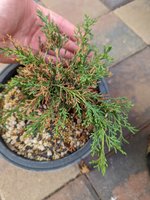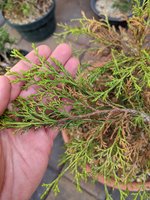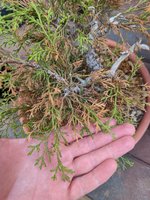eeeealmo
Mame
Hey Everyone - I have multiple shimpaku (both kishu and itoigawa) that are experiencing similar health problems that I can't seem to get under control. Interior foliage is turning a tan color while the apical tips continue to grow. The browning moves up the branch until the tip stops pushing and everything fails. The trees are in a variety of mediums from akadama/pumice/lava to an organic mix.
I've tried numerous fungicides including a copper spray, clearys3336 spray, and subdueMaxx. I'm at my wits end, and have no idea what to try to save what I can. Any help would be wonderful. Thanks!




I've tried numerous fungicides including a copper spray, clearys3336 spray, and subdueMaxx. I'm at my wits end, and have no idea what to try to save what I can. Any help would be wonderful. Thanks!






